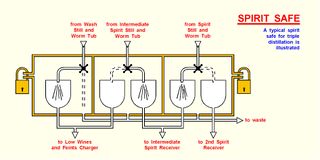Spirit safe: Difference between revisions
Jump to navigation
Jump to search
Uncle Jesse (talk | contribs) (Creating wanted page) |
Uncle Jesse (talk | contribs) mNo edit summary |
||
| Line 1: | Line 1: | ||
[[Image:Spiritsafediagram.jpg|thumb|320px|right|''Triple distillation Spirit Safe'']] | |||
Traditionally, distilleries used a Spirit Safe which allowed measurement of the [[distillate]] during [[distillation]], without allowing the person measuring to come into contact with the [[spirit]]. Only the Customs and Excise Officer who performed these measurements had the key to the Excise Lock on the Spirit Safe. | Traditionally, distilleries used a Spirit Safe which allowed measurement of the [[distillate]] during [[distillation]], without allowing the person measuring to come into contact with the [[spirit]]. Only the Customs and Excise Officer who performed these measurements had the key to the Excise Lock on the Spirit Safe. | ||
Scotland amended their laws in 1983 so that now the [[distillery]] manager and the Customs and Excise Officer both have a key. | Scotland amended their laws in 1983 so that now the [[distillery]] manager and the Customs and Excise Officer both have a key. | ||
[[Category:Equipment]] | [[Category:Equipment]] | ||
[[Category:Glossary]] | [[Category:Glossary]] | ||
Revision as of 21:09, 15 October 2017
Traditionally, distilleries used a Spirit Safe which allowed measurement of the distillate during distillation, without allowing the person measuring to come into contact with the spirit. Only the Customs and Excise Officer who performed these measurements had the key to the Excise Lock on the Spirit Safe.
Scotland amended their laws in 1983 so that now the distillery manager and the Customs and Excise Officer both have a key.
